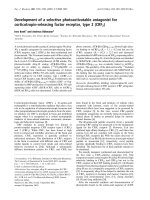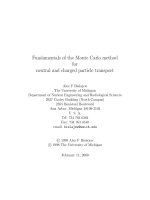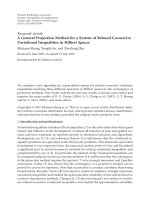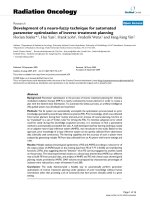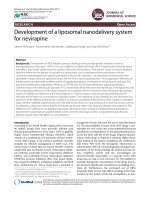Development of a fringe projection method for static and dynamic measurement
Bạn đang xem bản rút gọn của tài liệu. Xem và tải ngay bản đầy đủ của tài liệu tại đây (5.98 MB, 139 trang )
DEVELOPMENT OF A FRINGE PROJECTION
METHOD FOR STATIC AND DYNAMIC
MEASUREMENT
WU TAO
(B.Eng. (Hons.))
A THESIS SUBMITTED
FOR THE DEGREE OF MASTER OF ENGINEERING
DEPARTMENT OF MECHANICAL ENGINEERING
NATIONAL UNIVERSITY OF SINGAPORE
2003
ACKNOWLEDGEMENTS
I will like to express my sincere and deepest appreciation to his supervisors
Assoc. Prof Tay Cho Jui (Department of Mechanical Engineering) and Assist. Prof
Quan Chenggen (Department of Mechanical Engineering) for their invaluable advice
and guidance throughout this project. I would also like to express my gratitude to Mr.
Chiam Tow Jong, Mr. Fu Yu, Ms. Sherrie Han, and Mr. Abdul Malik from the
Experimental Mechanics Laboratory.
I would also like to thank my family. Their financial and spiritual support have
been enabled me to come to Singapore and study at an advanced academic level.
i
TABLE OF CONTENTS
ACKNOWLEDGEMENTS
i
TABLE OF CONTENTS
ii
SUMMARY
v
NOMENCLATURE
vii
LIST OF FIGURES
ix
CHAPTER 1
1
INTRODUCTION
1.1
Introduction
1
1.2
Problem
2
1.3
Objectives of the project
3
CHAPTER 2
LITERATURE REVIEW
4
2.1
Application of optical techniques in shape and deformation measurement
4
2.2
Application of optical techniques in dynamic measurement
5
2.3
Development of fringe projection method
7
2.4
Enhancement of dynamic range of optical system
8
2.5
3-D displacement measurement by optical techniques
9
2.6
Digital image correlation (DIC) technique
CHAPTER 3
3.1
11
THEORY
12
Formation of fringe patterns
12
3.1.1 Formation of fringe patterns by interferometry method
12
3.1.2 Formation of fringe patterna by a Liquid Crystal Display (LCD) Projector
14
3.2
Height and phase relationship
15
3.3
Determination of phase value
16
ii
3.4
Phase unwrapping
20
3.5
Enhancement of dynamic range of fringe projection method
21
3.6
Phase shift calibration
24
3.7
Integrated fringe projection and DIC method
24
CHAPTER 4
APPLICATION OF FRINGE PROJECTION METHOD FOR
STATIC MEASUREMENT
36
4.1
Experimental work
36
4.2
Results and discussion
37
CHAPTER 5
APPLICATION OF FRINGE PROJECTION METHOD FOR
DYNAMIC MEASUREMENT
5.1
Measurement of dynamic response of a small component
45
45
5.1.1 Experimental work
45
5.1.2 Results and discussion
46
5.2
48
Enhancement of dynamic range of the fringe projection method
5.2.1 Experimental work
49
5.2.2 Results and discussion
50
CHAPTER 6 INTEGRATED FRINGE PROJECTION AND DIC METHOD 71
6.1
Experimental Work
71
6.2
Results and discussion
72
CHAPTER 7
CONCLUSIONS AND RECOMMENDATIONS
94
7.1
Conclusions
94
7.2
Recommendations
97
References
98
APPENDIX A DERIVATION OF TIME-AVERAGE FRINGE PROJECTION
111
iii
APPENDIX B PROCEDURE OF FFT PROCESSING
113
B.1
Fast Fourier Transform
113
B.2
Bandpass Filter for the Fourier Transform Method
113
B.3
Inverse FFT
114
B.4
Unwrapping
115
APPENDIX C PHASE MAPS AT DIFFERENT INTERVALS
121
APPENDIX D LIST OF PUBLICATIONS
126
iv
SUMMARY
This thesis is divided into three parts: the first part establishes the theory for a
fringe projection method and its application to shape measurement for both static and
dynamic loading conditions. Experimental verification for both static shape
measurement and dynamic analysis is carried out on a micro membrane, a coin and a
diaphragm of a speaker. The experimental results show excellent agreement with
theoretical values.
Since the exposure period of a camera is reduced with high frame rate, dynamic
measurement with a short exposure is intrinsically light intensity starved. Thus
insufficiency in light intensity often introduces underexposure problem and leads to
poor image quality. To overcome this problem and enhance the dynamic range of the
system, a practical and simple method which involves a white light source (WLS) is
proposed and demonstrated. The theory is presented and an increase in the
measurement range of up to a factor of 6 was achieved.
Since the fringe projection method is mainly based on the height and out-ofplane displacement of the objects, it is observed that the in-plane displacement has
significantly adverse effects on the results. Therefore, measurement of 3-D
displacement is needed. A novel method combining the fringe projection and digital
image correlation (DIC) into one optical system is developed to simultaneously
measure displacement in three dimensions, where only one camera is used. In this
technique, linear sinusoidal fringes are first projected on an object using a fringe
v
projector and images of the object’s surface with the fringe pattern are captured by a
CCD camera. With the aid of Fourier transform, the carrier (fringe pattern) in the
images is eliminated while only the background intensity variation is preserved. DIC
is then used to obtain in-plane displacement based on the background images after
carrier elimination. In the mean time, original images are processed by fast Fourier
transform (FFT) technique to deliver information about shapes of the object. Based on
the in-plane displacement vector obtained by DIC, the shapes of the object in different
stages are compared in a reference coordinate to obtain out-of-plane displacement.
Experimental results of 3-D displacement field of a small component are obtained to
confirm the validity of the method.
vi
NOMENCLATURE
A, C , C *
Fourier spectra
a
Background intensity
aW
White light background introduced
b
Variation of fringe pattern
c*
Complex conjugate
D
Distance from the light source to the screen
d
Distance between two virtual points
f
Spectra frequency in x-direction
g
Distance between LCD and CCD
h
Height of the surface
IF
Resultant intensity of fringe pattern
I F'
Output intensity of fringe pattern
IO
Optimal intensity distribution
IP
Input intensity of fringe pattern
k
Coefficient relating Z to φ
L
Length from point A to the edge of the optical wedge
l
Distance between reference plane and CCD
n0
Refractive index of the optical wedge
P
Position of the investigated point
Po
Fringes’ pitch
Q
Centre of the imaging optics
vii
t
Thickness of an optical wedge
u0
Carrier frequency
W
3-D displacement vector
Z ( x, y, t ) Instant displacement of the vibration surface
Z ( x, y )
Vibration amplitude of one point at ( x, y )
α
Angle of incidence of the light
β
Refractive angle
θ
Initial phase angle of vibration
ω
Angular velocity of vibration
γ
Projection angle
λ
Wavelength of a He-Ne laser
ϕ 0 ( x, y )
Initial phase value
ϕ ( x, y )
Phase variable
ϕn
Phase shifting interval
δ
Phase value
δ (t )
Instant displacement
µ,υ
Contrast coefficient
∆x , ∆y , ∆z
Displacement in the x -, y - and z - directions
viii
LIST OF FIGURES
Figure 3.1
Schematic diagram of two-point-light-source interferometry with an
optical fiber and an optical wedge.
28
Figure 3.2
Optical geometry for fringe analysis.
29
Figure 3.3
Fourier fringe analysis.
30
(a) spectrum of the interferogram.
30
(b) Processed spectrum after filtering.
30
(a) Wrapped phase with 2π jump.
31
(b) Unwrapped phase value.
31
Figure 3.5
Intensity of fringe pattern enhanced by a white light source.
32
Figure 3.6
General scheme of the proposed integrated method.
33
Figure 3.7
Logical model of CRA.
34
Figure 3.8
Schematic diagram of planar deformation process.
35
Figure 4.1
Experimental setup for shape measurement of small components.
39
Figure 4.2
Microphone chip.
40
Figure 4.3
Cross section view of the microphone.
40
Figure 4.4
Image of the fringe pattern on the test surface.
41
Figure 4.5
Relationship between the phase value and height of the test surface. 42
Figure 4.6
3-D plot of the surface of the microphone.
43
Figure 4.7
Cross-section of the micro membrane at x = 125 µ m.
44
Figure 5.1
Experimental setup of fringe projection method for dynamic
Figure 3.4
Figure 5.2
measurement.
53
(a) Test specimen.
54
ix
(b) A close up view of the surface with fringe projection.
Figure 5.3
54
Sinusoidal fringe pattern projected on a small section of the test
specimen.
55
Figure 5.4
Images at 0.002s time interval.
56
Figure 5.5
Calibration of the fringe projection system for the measurement of
vibration in z direction.
57
Figure 5.6
Unwrapped phase maps at 0.002s time interval.
58
Figure 5.7
(a) Vibration amplitude before phase recovery.
59
(b) Vibration amplitude after phase recovery.
59
Figure 5.8
Vibration plots of different regions on the object.
60
Figure 5.9
Comparison of micro values and experimental vibration amplitude. 61
Figure 5.10
Experimental setup with the white light source.
62
Figure 5.11
A small section on the test coin surface.
63
Figure 5.12
Comparison of the images of part of coin recorded at recording rate of
Figure 5.13
3000 fps.
64
(a) Image recorded with background enhancement.
64
(b) Image recorded without background enhancement.
64
(c) Image processed with an optimal contrast.
64
Comparison of the fringe pattern distribution of the cross section of YY.
65
Figure 5.14
Figure 5.15
(a) 3-D profile of test object before background enhancement.
66
(b) 3-D profile of test object after background enhancement.
66
(a) Image of the speaker recorded without background enhancement at
frame rate of 3000 fps.
67
x
(b) Image of the speaker recorded with white light background
enhancement at frame rate of 3000 fps.
Figure 5.16
67
(a) 3-D profile of speaker diaphragm with background enhancement.68
(b) 3-D profile of the speaker without background enhancement.
68
Figure 5.17
Vibration amplitude of speaker diaphragm.
69
Figure 5.18
Comparison of vibration plots at 3000fps frame rate.
70
Figure 6.1
A close up view of a speaker diaphragm.
76
Figure 6.2
(a) Images of the test surface with fringe pattern with a pitch of 50
Figure 6.3
Figure 6.4
Figure 6.5
pixels.
77
(b) Recovery of intensity distribution of background.
77
(a) 3-D representation of the spectrum before filtering.
78
(b) 3-D representation of the spectrum after filtering.
79
(a) Images of the test surface with fringe pattern with a pitch of 15
pixels.
80
(b) Recovery of intensity distribution of background.
80
(a) Images of the test surface with fringe pattern with a pitch of 1 pixel.
81
(b) Recovery of intensity distribution of background by a 70 pixels ×
70 pixels filtering window.
82
(c) Recovery of intensity distribution of background by a 80 pixels ×
80 pixels filtering window.
83
(d) Recovery of intensity distribution of background by a 100 pixels ×
100 pixels filtering window.
84
(e) Recovery of intensity distribution of background by a 120 pixels ×
120 pixels filtering window.
xi
85
Figure 6.6
(a) A close up view of the test surface with fringe pattern before
displacement (225 µ m, 300 µ m and 140 µ m in x -, y - and z directions respectively).
86
(b) A close up view of the test surface with fringe pattern after
displacement (225 µ m, 300 µ m and 140 µ m in x -, y - and z directions respectively).
87
Figure 6.7
Phase map of the test surface.
88
Figure 6.8
Images of the background of the test surface after CRA.
89
(a) Image of the background of the test surface before displacement. 89
(b) Image of the background of the test surface after displacement. 90
Figure 6.9
Calibration of the measurement system.
91
(a) Calibration and error analysis of displacement along X direction. 91
(b) Calibration and error analysis of displacement along Y direction. 91
(c) Calibration and error analysis of out-of-plane displacement.
92
Figure 6.10
3-D displacement vector of the test surface.
93
Figure B.1
(a) Real part of the Fourier spectrum, (b) Imaginary part of the Fourier
spectrum, (c) Spectrum.
116
Figure B.2
Dialog box for the bandpass filter for the Fourier transform method.117
Figure B.3
(a) Filtered real part of the Fourier spectrum, (b) Filtered imaginary
part of the Fourier spectrum, (c) Amplitude spectrum of the result. 118
Figure B.4
(a) Back transformed real part of the Fourier spectrum, (b) Back
transformed imaginary part of the Fourier spectrum, (c) Mod 2π -phase.
119
Figure B.5
Unwrapped phase map.
120
Figure C.1
Phase maps at different time intervals
125
xii
Chapter 1 Introduction
1.1
Introduction
Optical techniques can be classified into either static or dynamic methods with
respect to the loading conditions. Some examples of the static approach are for shape
measurement and deformation measurement, while vibrational excitation belongs to
the dynamic measurement mode.
Projected fringes for the measurement of surface shape is a non-contact optical
method that has been widely recognized in the contour measurement of various
diffuse objects. The technique is referred to as fringe projection. This method uses
parallel or divergent fringes projected onto the object surface, either by a conventional
imaging system or by coherent light interfererence patterns, in which the projection
and recording directions are different. The resulting phase distribution of the measured
fringe pattern includes information on the surface height variation of the object. An
analysis of the fringe patterns is normally carried out either by the phase shifting
technique or the fast Fourier transform (FFT) method. Both produce wrapped phase
maps, where 2π phase jumps caused by the nature of arctangent must then be
removed by the process known as phase unwrapping to recover the surface heights.
Phase unwrapping is normally carried out by comparing the phase at neighboring
pixels by adding or subtracting. In application, the fringe projection method has been
proven to be a promising tool for deformation measurement and curvature
measurement purpose.
1
1.2
Problem
However, most research in fringe projection was based mainly on static
measurement with phase-shifting technique. In such application, static loading is
commonly applied to the test specimen to achieve the desired results. Over the years,
although descriptions of the technique were often presented, no formal treatment of
dynamic fringe projection had been dealt with.
Dynamic measurement by fringe projection, which can be coupled with either
static or dynamic measurement of the object, will enable the fringe pattern to be
monitored live as it is produced and as it changes with time under the action of a
varying load. This attribute makes dynamic measurement by fringe projection
particularly useful for monitoring both time-dependent and transient incidents.
If true 3-D displacement analysis is to be performed, the system must monitor
the objects with more than one camera. This will require multiple projection-detection
system, preferably working on the basis of the calibration principle, or with reference
to a precalibrated measurement volume. These methods can effectively monitor 3-D
displacement field, but most often two or more cameras are used to record 3-D
information about the objects. There are some key limitations of multiple camera
systems including 1) ill-suitability for dynamic measurement, 2) mismatch in the
triangulation of corresponding points and 3) a calibration process that is laborious and
time-consuming. Therefore single camera systems are greatly desired. Conventionally,
fringe projection method is mostly used in out-of-plane displacement.
2
1.3
Objectives of the Project
To formulate the fringe projection method for measuring components under
vibrational loading conditions and 3-D translation, the objectives of this project are as
follows:
1) To demonstrate the application of fringe projection method in both static and
dynamic measurement;
2) To enhance the dynamic range of the measurement system; and
3) To develop a novel fringe projection method integrated with digital image
correlation (DIC) technique which enables the determination of shape and 3-D
displacement using only one camera.
In the first chapter of the thesis, the objectives of this project are defined. The
historical development of optical techniques will be presented in chapter 2. Chapter 3
to 6 will cover the main part of the project. These will include the theoretical
derivation, the experimental techniques, followed by a detailed discussion on each of
these topics. Chapter 7 will give the conclusions and lay down some recommendations
for future investigation.
A list of publications arising out of this research is shown in Appendix D.
3
Chapter 2 Literature Review
2.1
Application of Optical Techniques in Shape and Deformation
Measurement
Optical metrology has been developed rapidly since 1960s. Since then the
surface measurement technique is regarded as one of the main components of optical
metrology. In the early days of optics, a laser scanning machine was used as a surface
detection tool. However, because of the time-consuming nature of point-by-point
measurements, it may take a long time to perform the surface measurement. The main
advantages of optical metrology, such as full field measurement, were utilized. Some
techniques, such as shadow moiré method, are still used in surface measurement.
Shadow moiré method [1-3] involves positioning a grating close to an object and its
shadow on the object is observed through the grating. The method is useful for
measuring 3-D shape of a relatively small object, however, the size of the object to be
measured is restricted to the grating size. The sensitivity of the method is from the
order of microns to that of millimeters depending on the frequency and the amount of
relative rotation of the grating.
Holographic method involves generation of a contour fringe pattern by two
reconstructed images of a double-exposure hologram. Thalmann and Dandliker [4]
reported holographic contouring using electronic phase measurement, which is based
on two-illumination source, and the use of a microcomputer for data reduction.
4
ESPI (electronic speckle pattern interferometry), which is based on laser diodes
and single-mode fiber optics is also developed for measuring surface contour [5].
However, poor quality of the contouring images remains the main limitation of this
technique for surface measurement.
Shearography [6, 7] has also been used in surface shape measurement. Unlike
holography, shearography does not require special vibration isolation since a separate
reference beam is not required; hence, it is a practical tool that can be used in an
industrial environment. Optical grating methods have been applied to the
measurement of 3-D shape [8-10]. In this method five separate defocused images
using Ronchi grating are projected onto an object and the deformed grating images are
captured by a CCD camera and evaluated by the phase-shifting technique. The method
is used for relatively large objects.
By the end of 1980s, computer vision with refractive moiré and projection fringe
methods were developed for surface measurement. As classical approaches using
mechanical probes remain inherently slow and ill suited for measurement of curved
surfaces, 3-D sensing by non-contact optical methods are studied extensively for these
applications. In industrial metrology, the non-contacting and non-destructive
automated surface shape measurement technique is a desirable tool for vibration
analysis, quality control, and contour mapping.
2.2
Application of Optical Techniques in Dynamic Measurement
5
The discussion so far has emphasized mainly on the static shape and curvature
measurement of test specimens. In industrial metrology, a non-contact and nondestructive vibration measurement technique is a desirable tool for contour mapping,
quality control and vibration analysis. Optical techniques for vibration measurement
have been well established and can be traced to the earlier days of optical methods.
The development of laser Doppler vibrometers (LDV) [11, 12] for use in engineering
testing was stimulated by the advances of easily detecting sub-nm amplitudes devices
over a frequency range from static to MHz. However, laser vibrometers are generally
intended to make measurements at a single point on the surface of a test object. Some
solutions for the whole-field measurement of vibration with optical techniques have
been successfully proposed. Hung [13] employed shearography method to vibration
measurement by digitizing speckle images of a deforming object using a high-speed
digital image acquisition system. Moore [14] presented an Electronic Speckle Pattern
Interferometer (ESPI) system that has enabled non-harmonic vibrations to be
measured with micro second temporal resolution. Kokidko [15] developed the shadow
Moiré method to measure deformation of a plastic panel by using high-speed
photography. Nemes [16] presented a system based on grating projection and Fast
Fourier Transform (FFT) technique to measure the transient surface shape in a
polymer membrane inflation test. FFT technique with carrier fringe method [17, 18]
has also been widely employed in dynamic measurement as the technique requires
only one image for phase determination. Other methods [19, 20] based on a highspeed camera, using FFT technique have also been reported. Tiziani [21-24]
developed pulsed digital holography for measurement of deformations and vibrations
for various objects. Using time-averaged method, holographic method allows
measurement of shape of structures subjected to vibration excitation. Chambard [25]
6
extended the method to include pulsed-TV holography for vibration analysis
applications. Real-time pulsed ESPI [26] (Electronic Speckle Pattern Interferometry)
based on a high precision scheme that synchronizes and fixes an object point during
rotation is used to study out-of-plane vibrations in a noisy environment. Aslan [27]
developed a real time laser interferometry system for measurement of displacement in
hostile environment.
2.3
Development of fringe projection method
Fringe projection method is a suitable method for three-dimensional optical
topometry [28-36]. It is a useful addition to other methods such as confocal
microscopy [37-40] and white-light interferometry [41-43]. Pixel-related devices offer
a much wider range of possibilities, since virtually all desired intensity distributions
can be generated. Triangulation and fringe projection are very appropriate and the
most frequently employed techniques for macroscopic shape analysis. For fringe
projection, a grating, e.g. with a sinusoidal intensity distribution, is imaged onto the
surface for the measurement. The fringe deformation is used for height calculation.
Typically only a few video-frames are need to be recorded in order to obtain a full
field 3D measurement. The image processing based measurement principle enables
very fast measurement. Phase values are determined by calculating Fourier
transformation, filtering in the spatial frequency domain and calculating inverse
Fourier transformation. Compared with the moiré topography, fast Fourier transform
method can accomplish a fully automatic distinction between a depression and an
evaluation of the object shape. It requires no fringe order assignments or fringe center
7
determination and requires no interpolation between fringes because it gives the
height distribution at every pixel over the entire fields.
After Takeda [44], the FFT method has been extensively studied [45]. A twodimensional Fourier transform is applied to provide a better separation of the height
information from noise when speckle-like structures and discontinuities exist in the
fringe pattern.
2.4
Enhancement of Dynamic Range of Optical System
An important problem remains in dynamic imaging systems is underexposure of
a CCD sensor in high-speed application. At a high frame rate, the exposure period of a
CCD camera is decreased and hence reduced intensity is absorbed by the photosensors
in the CCD [46]. This will result in insufficient information being recorded. This
problem becomes more serious when the system is used to measure microcomponents with a Long-Distance Microscope (LDM) which has a limited aperture.
Hence acquisition of image becomes an optimization problem of adapting the
dynamic range of the scene to the dynamic range of the camera.
To modulate the intensity in dark and bright areas, Tiziani [47] developed a
method by the use of a three-chip color camera (RGB). The three-color channels are
recorded simultaneously and the combined output of the RGB channels allows the use
of full spatial resolution for each color channel as compared to a one-chip color CCD
camera. To overcome the problem of low intensity Pedrini [48] presented a method
which employs an image intensifier coupled to a CCD sensor. The image intensifier
8
together with an electronic shutter action allow recording of dim test surface with a
short exposure period. To improve the shuttering characteristic Ito [49] suggested a
method which consists of a proximity focused image intensifier with a micro-channel
plate and an external transparent electrode. The method can effectively increase the
intensity on the specimen to fall within the dynamic range of the camera. However,
the apparatus used is somewhat luxurious and data processing is complex.
2.5
3-D Displacement Measurement by Optical Techniques
In many areas of physics and engineering, measurement of three-dimensional
displacement fields for an object that is being translated is of great interest. Within
optical metrology, several techniques that measure all three components of a
deformation simultaneously already exist. Formerly, the most widely used technique
in this regard was speckle photography. This technique essentially consists of
recording incoherent superposition of two or more speckle patterns generated before
and after the motion of object and then analyzing the recorded speckle-gram by
Fourier transform to reveal the object deformation. Some works in this field dealt with
only in-plane displacement or out-of-plane displacement. But, in practice, the two
kinds of motions are often coupled together. So it is always desirable to have a single
technique providing a measure of the total object motion with effective in-plane and
out-of-plane components.
Several speckle-based techniques for 3-D displacement measurement have been
developed. One of them used both He-Ne laser and polychromatic dye laser; some
others obtained results by analyzing the null-speckle displacement ring. These
9
requirements introduce some inconvenience in system architecture or inaccuracy in
measurement. Recently a technique using a photorefractive speckle correlator has
been proposed. In this technique a double- or multi-exposure speckle interferogram is
recorded with the use of a photorefractive crystal, and this interferogram is then
placed as an input in a Fourier transform system to get correlation spots. The position
of the spot is the indication of the object motion. Still this method has some
drawbacks. First, the use of correlation operation increases the complexity and time of
measurement. Second, for general 3-D displacement and tilt, the correlation spot and
the dc term are not in the same plane, so we have to move the observation plane
longitudinally to meet the focus position of correlation term. Since the longitudinal
distribution of the correlation spot changes gradually, it is not always easy to locate
exactly its sharpest spot, consequently this gives rise to another error source.
Two or three-beam holography is suitable when the deformation components
are of equal magnitude and small. Chiang [50, 51] has developed at least two different
techniques. One is based on moiré interferometry and the other is called holospeckle
interferometry where the in-plane components of the deformation are analyzed using
speckle photography and the out-of-plane component by holographic interferometry.
The non-interferometric methods use stereovision to obtain the true deformation field
by capturing the apparent motion of a reference pattern from two cameras in space.
Henao [52] developed a technique where a diffraction grating was used to form
stereovision. During the last decade several researchers [53-55] have presented
systems based on digital correlation algorithms combined with a stereo pair of CCD
cameras. Such systems can handle discontinuities in the deformation and measure
deformations. Pawlowski [56] applied a spatio-temporal approach, in which the
10
temporal analysis of the intensity variation at a given pixel provides information about
out-of-plane displacement. In-plane motion of the object is determined by a
photogrammetry-based marker tracking method.
2.6 Digital image correlation (DIC) technique
Digital image correlation (DIC) is a non-contact optical method for displacement
of strain measurement, which was introduced by Sutton in 1980s [57]. Currently it has
been well developed and applied to many industrial fields [58-66] as a robust
measurement method. The technique is based on the gray level correlation between
the two digital images in the undeformed and deformed states. The natural or artificial
surface patterns in the images are the carrier that records the surface displacement
information of an object. By making use of the correlation algorithm of gray level of
the pixels in the two images, the displacement fields can be obtained.
11
Chapter 3 Theory
3.1
Formation of Fringe Patterns
There are different approaches for generating fringe patterns such as
interferometry, triangulation and spatial light modulating by a liquid crystal modulator.
3.1.1
Formation of Fringe patterns by Interferometry Method
The arrangement that incorporates an optical wedge, enables a fringe pattern
with a fine pitch to be obtained. This technique has the advantage of requiring a
simple experimental setup and optical arrangement. Due to laser interference in a
perfect common path the proposed fringe projector is compact and provides a stable
and highly visible fringe pattern. This is suitable for micro-components measurement.
As shown in Fig. 3.1(a), the fiber end S of an optical fibre acts as a point light
source and emits a spherical wave front. The wave front is split into two portions,
which correspond to EFGH and E1 F1G1 H 1 , respectively. Interference fringes in the
superimposed area E1 F1GH of the two portions are formed from the coherent light of
two point light sources, S 1 and S 2 , and are equivalent to a pair of pinholes in Young’s
interferometer configuration, as shown in Fig. 3.1(b). Young’s fringes with a
sinusoidal light intensity distribution will thus emerge on the observation screen [67,
68]. The fringes’ pitch P0 is given by
12



